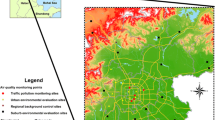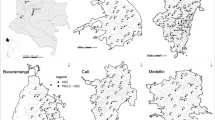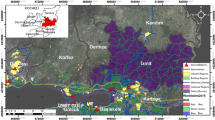Abstract
Particulate material 10 μm (PM10) and sulfur dioxide (SO2) are representative air pollutants in Northeast China and may contribute more to the morbidity of respiratory and cardiovascular disease than may other pollutants. Up to now, there have been few studies on the relation between health effect and air pollution by PM10 and SO2 in Northeast China, which may be due to the lack of a model for determination of air pollution exposure. For the first time, we used daily concentration data and influencing factors (different type of land use, road length and population density, and weather conditions as well) to develop land use regression models for spatial distribution of PM10 and SO2 in a central city in Northeast China in both heating and non-heating months. The final models of SO2 and PM10 estimation showed good performance (heating months: R2 = 0.88 for SO2, R2 = 0.88 for PM10; non-heating months: R2 = 0.79 for SO2; R2 = 0.87 for PM10). Estimated concentrations of air pollutants were more affected by population density in heating seasons and land use area in non-heating seasons. We used the land use regression (LUR) models developed to predict pollutant levels in nine districts in Shenyang and conducted a correlation analysis between air pollutant levels and hospital admission rates for childhood asthma. There were high associations between asthma hospital admission rates and air pollution levels of SO2 and PM10, which indicated the usability of the LUR models and the need for more concern about the health effects of SO2 and PM10 in Northeast China. This study may contribute to epidemiological research on the relation between air pollutant exposure and typical chronic disease in Northeast China as well as providing the government with more scientific recommendations for air pollution prevention.







Similar content being viewed by others
Availability of data and material
Data and material will be available under suitable requirements.
References
Amini, H., Taghavi-Shahri, S. M., Henderson, S. B., Naddafi, K., Nabizadeh, R., & Yunesian, M. (2014). Land use regression models to estimate the annual and seasonal spatial variability of sulfur dioxide and particulate matter in Tehran, Iran. Science of the Total Environment, 488-489, 343–353.
Bazyar, J., Pourvakhshoori, N., Khankeh, H., et al. (2019). A comprehensive evaluation of the association between ambient air pollution and adverse health outcomes of major organ systems: a systematic review with a worldwide approach. Environmental Science and Pollution Research International, 26(13), 12648–12661.
Beelen, R., Hoek, G., Vienneau, D., et al. (2013). Development of NO2 and NOx land use regression models for estimating air pollution exposure in 36 study areas in Europe-The ESCAPE project. Atmospheric Environment, 72, 10–23.
Cattani, G., Gaeta, A., di Bucchianico, A. M., et al. (2017). Development of land-use regression models for exposure assessment to ultrafine particles in Rome, Italy. Atmospheric Environment, 156, 52–60.
Chai, R., Xie, H., Zhang, J., Ma, Z., et al. (2018). Sulfur dioxide exposure reduces the quantity of CD19+ cells and causes nasal epithelial injury in rats. Journal of Occupational Medicine and Toxicology, 27, 13–22.
Chen, L., Baili, Z., Kong, S., Han, B., You, Y., Ding, X., du, S., & Liu, A. (2010). A land use regression for predicting NO2 and PM10 concentrations in different seasons in Tianjin region, China. Journal of Environmental Sciences (China), 22(9), 1364–1373.
Chen, L., Du, S., Bai, Z., et al. (2017). Application of land use regression for estimating concentrations of major outdoor air pollutants in Jinan, China. Journal of Zhejiang University Science A (Appl Phys & Eng), 11(11), 857–867.
Ebisu, K., Berman, J. D., Bell, M. L., et al. (2016). Exposure to coarse particulate matter during gestation and birth weight in the U.S. Environment International, 94, 519–524.
Eeftens, M., Beelen, R., de Hoogh, K., et al.(2012). Development of Land Use Regression Models for PM , PM Absorbance, PM and PM in 20 European Study Areas; Results of the ESCAPE Project. Environmental Science & Technology, 46(20), 11195-11205.
Gulliver, J., Morris, C., Lee, K., Vienneau, D., Briggs, D., & Hansell, A. (2011). Land use regression modeling to estimate historic (1962-1991) concentrations of black smoke and sulfur dioxide for Great Britain. Environmental Science & Technology, 45(8), 3526–3532.
Hehua, Z., Qing, C., Shanyan, G., Qijun, W., & Yuhong, Z. (2017). The impact of prenatal exposure to air pollution on childhood wheezing and asthma: a systematic review. Environmental Research, 159, 519–530.
Huang, L., Zhang, C., & Bi, J. (2017). Development of land use regression models for PM2.5, SO2, NO2 and O3 in Nanjing, China. Environmental Research, 158, 542–552.
Jin, L., Guo, X., Dou, J., Liu, B., Wang, J., Li, J., Sun, M., Sun, C., Yu, Y., & Yao, Y. (2018). Multimorbidity analysis according to sex and age towards cardiovascular diseases of adults in Northeast China. Scientific Reports, 8(1), 8607.
Kashima, S., Yorifuji, T., Sawada, N., Nakaya, T., & Eboshida, A. (2018). Comparison of land use regression models for NO2 based on routine and campaign monitoring data from an urban area of Japan. Science of the Total Environment, 631-632, 1029–1037.
Lee, M., Brauer, M., Wong, P., Tang, R., Tsui, T. H., Choi, C., Cheng, W., Lai, P. C., Tian, L., Thach, T. Q., Allen, R., & Barratt, B. (2017). Land use regression modelling of air pollution in high density high rise cities: a case study in Hong Kong. Science of the Total Environment, 592, 306–315.
Li, J., Liu, H., Lv, Z., et al. (2018). Estimation of PM2.5 mortality burden in China with new exposure estimation and local concentration-response function. Environmental Pollution, 243(Pt B), 1710–1718.
Liao, J., Yu, H., Xia, W., Zhang, B., Lu, B., Cao, Z., Liang, S., Hu, K., Xu, S., & Li, Y. (2018). Exposure to ambient fine particulate matter during pregnancy and gestational weight gain. Environment International, 119, 407–412.
Liu, C., Henderson, B. H., Wang, D., Yang, X., & Peng, Z. R. (2016a). A land use regression application into assessing spatial variation of intra-urban fine particulate matter (PM2.5) and nitrogen dioxide (NO2) concentrations in City of Shanghai, China. Science of the Total Environment, 565, 607–615.
Liu, Y., Astell-Burt, T., Liu, J., et al. (2016b). Spatiotemporal variations in lung cancer mortality in china between 2006 and 2012: a multilevel analysis. International Journal of Environmental Research and Public Health, 13(12), E1252.
Liu, M., Peng, X., Meng, Z., Zhou, T., Long, L., & She, Q. (2019). Spatial characteristics and determinants of in-traffic black carbon in Shanghai, China: combination of mobile monitoring and land use regression model. Science of the Total Environment, 658, 51–61.
Meng, X., Chen, L., Cai, J., et al. (2015). A land use regression model for estimating the NO2 concentration in Shanghai, China. Environmental Research, 137, 308–315.
Meng, X., Fu, Q., Ma, Z., et al. (2016). Estimating ground-level PM(10) in a Chinese city by combining satellite data, meteorological information and a land use regression model. Environmental Pollution, 208(Pt A), 177–184.
Minet, L., Gehr, R., & Hatzopoulou, M. (2017). Capturing the sensitivity of land-use regression models to short-term mobile monitoring campaigns using air pollution micro-sensors. Environmental Pollution, 230, 280–290.
Seabrook, J. A., Smith, A., Clark, A. F., et al. (2018). Geospatial analyses of adverse birth outcomes in Southwestern Ontario: examining the impact of environmental factors. Environmental Research, 172, 18–26.
Shi, Y., Lau, KK., Ng E. (2016). Developing street-level PM and PM land use regression models in high-density Hong Kong with Urban Morphological Factors. Environmental Science & Technology, 50(15), 8178-8187.
Shi, Y., Lau, K. K., & Ng, E. (2017). Incorporating wind availability into land use regression modelling of air quality in mountainous high-density urban environment. Environmental Research, 157, 17–29.
Vinceti, M., Malagoli, C., Malavolti, M., et al. (2016). Does maternal exposure to benzene and PM10 during pregnancy increase the risk of congenital anomalies? A population-based case-control study. Science of the Total Environment, 541(15), 444–450.
Wolf, K., Cyrys, J., Harcinikova, T., et al. (2017). Land use regression modeling of ultrafine particles, ozone, nitrogen oxides and markers of particulate matter pollution in Augsburg, Germany. Science of the Total Environment, 579, 1531–1540.
Wu, J., Li, J., Peng, J., et al. (2015). Applying land use regression model to estimate spatial variation of PM(2).(5) in Beijing, China. Environmental Science and Pollution Research International, 22(9), 7045–7061.
Yang, X., Zheng, Y., Geng, G., Liu, H., Man, H., Lv, Z., He, K., & de Hoogh, K. (2017). Development of PM2.5 and NO2 models in a LUR framework incorporating satellite remote sensing and air quality model data in Pearl River Delta region, China. Environmental Pollution, 226, 143–153.
Zhao, N., Qiu, J., Ma, S., Zhang, Y., Lin, X., Tang, Z., Zhang, H., Huang, H., Ma, N., Huang, Y., Bell, M. L., Liu, Q., & Zhang, Y. (2018). Effects of prenatal exposure to ambient air pollutant PM10 on ultrasound measured fetal growth. International Journal of Epidemiology, 47(4), 1072–1081.
Acknowledgments
We acknowledge the data support from Shenyang Environmental Monitoring Center and Institute of Geographic Sciences and Natural Resources Research, Chinese Academy of Sciences.
Funding
This work was supported by the National Key R&D Project of China (grant no. 2017YFC0907402, 2017]).
Author information
Authors and Affiliations
Contributions
Hehua Zhang did all the data processing and wrote the paper, and Yuhong Zhao designed the entire study process and reviewed the work.
Corresponding author
Ethics declarations
Ethics approval and consent to participate
This study did not involve any human or animal data; it was deemed negligible risk research and was exempt from ethical review by the Human Research Ethics Committee of Shengjing Hospital of China Medical University, and thus, no consent was required.
Consent for publication
All authors give their consent for publication.
Competing interests
The authors declare that they have no competing interests.
Additional information
Publisher’s note
Springer Nature remains neutral with regard to jurisdictional claims in published maps and institutional affiliations.
Rights and permissions
About this article
Cite this article
Zhang, H., Zhao, Y. Land use regression for spatial distribution of urban particulate matter (PM10) and sulfur dioxide (SO2) in a heavily polluted city in Northeast China. Environ Monit Assess 191, 712 (2019). https://doi.org/10.1007/s10661-019-7905-2
Received:
Accepted:
Published:
DOI: https://doi.org/10.1007/s10661-019-7905-2




